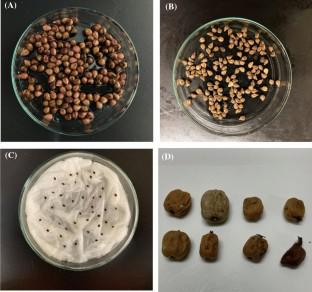Oecologia ( IF 2.7 ) Pub Date : 2024-01-24 , DOI: 10.1007/s00442-024-05510-5 Yoshihiro Tsunamoto , Hifumi Tsuruga , Konomi Kobayashi , Takeshi Sukegawa , Takuya Asakura

|
Megafauna are important seed dispersers because they can disperse large quantities of seeds over long distances. In Hokkaido, Japan, the largest terrestrial animal is the brown bear (Ursus arctos) and other megafauna seed dispersers are lacking. Thus, brown bears are expected to have an important function as seed dispersers in Hokkaido. In this study, we, for the first time, evaluated the seed dispersal function of brown bears in Hokkaido using three fleshy-fruited trees and studied: (1) gut passage time (GPT) in feeding experiments, (2) seed dispersal distance using tracking data of wild bears, and (3) the effect of gut passage and pulp removal on germination rate. Most seeds were defecated intact, and less than 6% were broken. The average GPT without pulp was 3 h and 56 min to 6 h and 13 min, depending on the plant and trial. Each plant’s average simulated seed dispersal distance was 202–512 m. The dispersal distance of Actinidia arguta seeds with pulp was significantly longer than those without pulp because of their longer GPT. The germination rate of defecated seeds without pulp was 19–51%, depending on the plant, and was significantly higher or not different comparing with that of seeds with pulp. We concluded that brown bears in Hokkaido are effective seed dispersers. In managing brown bears in Hokkaido, such ecological functions should be considered along with conserving the bear population and reducing human–bear conflicts.
中文翻译:

日本北部北海道岛上棕熊 Ursus arctos 的种子传播功能:肠道通过时间、传播距离、发芽和残留果肉的影响
巨型动物是重要的种子传播者,因为它们可以长距离传播大量种子。在日本北海道,最大的陆生动物是棕熊(Ursus arctos),缺乏其他巨型动物种子传播者。因此,棕熊有望在北海道发挥种子传播者的重要作用。在这项研究中,我们首次使用三种肉果树评估了北海道棕熊的种子传播功能,并研究了:(1)进食实验中的肠道通过时间(GPT),(2)利用野熊的追踪数据,以及(3)肠道通过和果肉去除对发芽率的影响。大多数种子完好无损地排出,只有不到 6% 破损。无果肉的平均 GPT 为 3 小时 56 分钟至 6 小时 13 分钟,具体取决于工厂和试验。每株植物的平均模拟种子传播距离为 202-512 m。有果肉的软枣猕猴桃种子由于GPT较长,其传播距离明显长于无果肉的种子。无果肉的排便种子的发芽率为 19-51%,具体取决于植物,与有果肉的种子相比显着较高或没有差异。我们得出的结论是,北海道的棕熊是有效的种子传播者。在北海道管理棕熊时,应在保护熊种群和减少人与熊冲突的同时考虑这种生态功能。



























 京公网安备 11010802027423号
京公网安备 11010802027423号